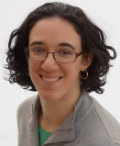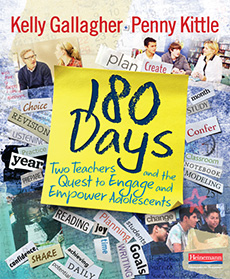A Look Inside Two Star Teachers’ Classrooms
180 Days: Two Teachers and the Quest to Engage and Empower Adolescents
By Kelly Gallagher and Penny Kittle
(Heinemann, 2018 – Learn more)

Between Kelly Gallagher and Penny Kittle, they have spent over 60 years teaching in public schools — he in hot and crowded Anaheim, California, and she among the White Mountains of northern New Hampshire.
It would be a gift to spend a school year in either of their classrooms, and this book is an attempt to bring faraway teachers closer in to see their daily practices and units across the school year.
180 Days is set up to answer the questions that all teachers ask: What do we teach? When in the school year do we teach it? What is going to get extended time and practice? What will we leave out? What will be re-taught in a later unit?
Teaching to the hidden standards

Instead of assigning projects, study guides, reading quizzes, and vocabulary activities to fill time, they believe in planning to reach what they call “hidden standards.” Those hidden standards include engagement in reading and writing and finding joy in reading, and those standards are accessed through choice, relevance, and classroom culture.
One way that Penny and Kelly access the hidden standards is through a deliberate pacing of writing units across the school year, beginning with narratives and moving towards multi-genre at the end of the school year.
Another way they access the hidden standards is by making whole class novel reading units short and thematic with multiple access points and parallel texts to avoid turning classic texts “into an extended worksheet” (67). This text is filled with examples of mentor texts, mini lessons, unit plans, and teacher talk that show teachers what it’s like to be a student in their classrooms.
But what about students who struggle with the hidden standards?
These hidden standards are worthy, but attaining them is hard – perhaps, at times, harder than Penny and Kelly realize. In their introduction, they write, “It takes time – weeks of time – to establish regular independent reading both inside and outside class in students’ increasingly distracted and busy lives” (12). Later on, they write, “just as joy and energy are contagious in a classroom, so are disengagement and lethargy” (98).
What should happen then? Should the teacher who is faced with a group of students who seem uninterested in reading beyond answering multiple choice questions on a quiz spend more time doing read-alouds and book talks? Should the teacher dive into a whole class novel unit because it will provide some structure? Or should that teacher move on to trying some of the multimedia composition projects outlined in the book?
It’s easy to determine how to spend time when students are engaged in the work, but it can be hard to figure out how to spend time when student motivation is lagging.
It’s good to see that even the pros struggle with these questions: Kelly writes about a class that had difficulty focusing during independent writing time, and as a result he had to “walk the class” instead of confer with students (110). I would have been interested to learn more about how he felt about the time lost in conferring given the value he and Penny place on conferences throughout the text.
24 hours in a day
The other question to address is how teachers should prioritize their planning time in order to help students access the hidden curriculum. In both Penny and Kelly’s classrooms, there are daily book talks and daily writing prompts. That means for 180 days of school, there are 180 book talk plans and 180 writing prompts, not to mention mentor and demonstration texts. Collecting 360 suggestions, ideas, and prompts could take one’s entire planning period, not to mention the assessment, reflections, and paperwork students are generating to hold themselves accountable to reading and writing.
Ideally, Penny and Kelly would weigh in on how they prioritize their planning and instructional time and how they recommend teachers build up their repertoire. There are several resources that I use to help plan for reading and writing, ranging from the book recommendations from teen librarians on YALSA’s HUB to the Mentor Text Dropbox from Moving Writers. A directory of resources would have been helpful, as would a guiding philosophy about which activities take precedence and which can be let go when it’s too late and the to-do list is too long.
If anything, this book makes it clear that teachers have a lot to learn from their students. While learning is a messy process, the end results are worth the journey.
Amy Estersohn is an English teacher in New York. Her Twitter handle is @EnglMsE.






























